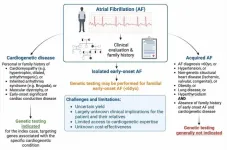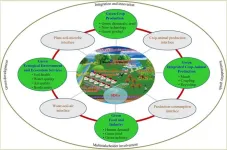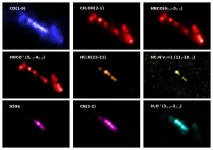(Press-News.org) Lower-income communities across the United States have long been much slower to adopt solar power than their affluent neighbors, even when local and federal agencies offer tax breaks and other financial incentives.
But, commercial and industrial rooftops, such as those atop retail buildings and factories, offer a big opportunity to reduce what researchers call the “solar equity gap,” according to a new study, published in Nature Energy and led by researchers at Stanford University.
“The solar equity gap is a serious problem in disadvantaged communities, in part because of income inequalities, but also because residential solar isn’t usually practical for people who don’t own their homes,” said Ram Rajagopal, senior author of the study and associate professor of civil and environmental engineering and of electrical engineering at Stanford. “This new study shows that commercial and industrial properties have the capacity to host solar resources to fill in part of that gap.”
Untapped resources
First, the bad news. The researchers found that non-residential rooftops generate 38% less electricity in disadvantaged communities than in wealthier ones. That gap, which is mainly because of lower deployment in poorer areas, has widened over the past two decades. Nevertheless, this gap is significantly lower than that of residential solar in these neighborhoods.
The good news, the researchers say, is that non-residential buildings have large unused capacity to produce solar power for their own benefit and to supply the communities around them. In low-income communities, commercial enterprises may be more responsive to government incentives for solar power than households are. An earlier study by the same researchers found that residential customers in disadvantaged communities, who may have fewer financial resources and often don’t own their homes, show less response to tax breaks and other financial inducements.
“Using Stanford’s DeepSolar database, we estimated that solar arrays on non-residential buildings could meet more than a fifth of annual residential electricity demand in almost two-thirds of disadvantaged communities,” said Moritz Wussow, the study’s lead author.
“Also, the raw cost of that power would be less in many communities than the residential rates that local electric utilities charge,” said Wussow, who was a visiting student researcher in Rajagopal’s lab group in 2022 and 2023.
To quantify the distribution of non-residential solar power installations, the researchers used satellite images and artificial intelligence to identify the number and size of rooftop solar arrays in 72,739 census tracts across the United States. About one-third of those tracts are deemed disadvantaged by the U.S. government.
The team tracked non-residential solar deployment as well as the amount of unused rooftops that would be good candidates for solar installation from 2006 through 2016 and then again for 2022. They then calculated the average annual cost of producing solar electricity in each area, based on the amount of local sun exposure and other variables. The costs ranged from about 6.4 cents per kilowatt-hour in sun-drenched New Mexico to almost 11 cents in Alaska. But those costs were lower than residential electricity rates in many of those areas – even in many northern states.
Chad Zanocco, a co-author of the new study and a postdoctoral fellow in civil and environmental engineering, noted that getting the power to residential areas would include other costs, such as battery storage and the construction of microgrids.
“We estimate that battery storage would increase total system costs by about 50%, but even that would be practical in almost two-thirds of the disadvantaged communities we studied,” Zanocco said.
Economies of scale
If commercial and industrial solar arrays can feed their surplus electricity into local power grids, the researchers write, lower-income residents could gain access through community subscriptions rather than by building their own rooftop panels. Commercial and industrial sites also offer greater economies of scale, compared to individual household solar panels. Another big advantage is that non-residential power customers could also be highly sensitive to tax incentives and other government inducements, leading to greater adoption.
Further lowering barriers, the researchers noted, is the Inflation Reduction Act of 2022 which has provided billions of dollars for states and local communities for clean-energy infrastructure. That money has already reduced the cost of new microgrids.
“Beyond reducing carbon emissions and slowing climate change, increased access to solar power would offer tangible local benefits to lower-income communities,” said Zhecheng Wang, a co-author and a postdoctoral fellow at Stanford’s Institute for Human-Centered Artificial Intelligence.
“This would promote local clean and low-cost energy generation, which would also increase the resilience from outages and reduce the pollution caused by fossil fuel power plants – many of which are located in low-income areas.”
Additional Stanford co-authors on the paper are: Rajanie Prabha, a PhD student in Civil & Environmental Engineering; June Flora, a senior research scholar in Civil & Environmental Engineering, and in Stanford’s School of Medicine; and Arun Majumdar, dean of Stanford Doerr School of Sustainability, professor in the departments of Energy Science & Engineering, of Mechanical Engineering, and of Photon Science at SLAC National Accelerator Laboratory, and senior fellow at the Precourt Institute and Stanford Woods Institute for the Environment. Civil & Environmental Engineering is a joint department of the Stanford School of Engineering and the Stanford Doerr School of Sustainability. Dirk Neumann, a professor of information systems research at Albert-Ludwigs-Universität in Freiburg, Germany, is also a co-author. Ram Rajagopal is also co-director of the Bits & Watts Initiative at the Precourt Institute for Energy, which is part of the Stanford Doerr School of Sustainability.
END
How commercial rooftop solar power could bring affordable clean energy to low-income homes
A new study led by Stanford researchers finds that factory and warehouse rooftops offer a big untapped opportunity to help disadvantaged communities bridge the solar energy divide.
2024-03-28
ELSE PRESS RELEASES FROM THIS DATE:
Taking a closer look at pulmonary fibrosis genetics
2024-03-28
PHOENIX, Ariz. — March 28, 2024 — Regulators of gene expression are thought to play an outsized role in disorders from cancers to heart disease. But how exactly do variations in gene regulation translate into a disease’s biology?
A team of scientists led by researchers from the Translational Genomics Research Institute (TGen), part of the City of Hope, together with investigators at St. Vincent’s Institute of Medical Research and Vanderbilt University Medical Center, now have a better answer for this question when it comes to pulmonary fibrosis (PF), an incurable respiratory disease.
Their study, published today in Nature Genetics, is the first to look at these ...
Cats with MDR1 mutation at risk of severe reactions to popular medication
2024-03-28
PULLMAN, WA -- More than half a million cats in the United States could be at risk of a severe or even fatal neurological reaction to the active ingredient in some top-selling parasite preventatives for felines.
While the ingredient, eprinomectin, which is found in products like NexGard COMBO and Centragard, appears safe and effective for the significant majority of cats when used at label doses, a study conducted by Washington State University’s Program for Individualized Medicine identified a risk of severe adverse effects in cats with the ...
IOP Publishing and IPEM mandate reporting of sex and gender in research
2024-03-28
IOP Publishing (IOPP) and the Institute of Physics and Engineering (IPEM) have introduced checks for sex and gender equality for all manuscripts submitted to their jointly published journal Physiological Measurement.
In line with the Sex and Gender Equity in Research (SAGER) guidelines, which were introduced to ensure that sex and gender considerations are appropriately reported in scholarly literature, all research published in Physiological Measurement must declare the sex and gender balance of subject groups. Authors are ...
Dogs trained to detect trauma stress by smelling humans’ breath
2024-03-28
Dogs’ sensitive noses can detect the early warning signs of many potentially dangerous medical situations, like an impending seizure or sudden hypoglycemia. Now, scientists have found evidence that assistance dogs might even be able to sniff out an oncoming PTSD flashback, by teaching two dogs to alert to the breath of people who have been reminded of traumas.
“PTSD service dogs are already trained to assist people during episodes of distress,” said Laura Kiiroja of Dalhousie University, first author of the paper ...
Electronic device thermal management made simpler and slightly better!
2024-03-28
Dr. Cheol-Woo Ahn, leading a research team at the Department of Functional Ceramics within the Ceramic Materials Division at the Korea Institute of Materials Science(KIMS), has developed the world's first heat dissipation material. This material reduces hydrophilicity through a chemical reaction that forms a nanocrystalline composite layer and increases thermal conductivity by controlling point defects. This process occurs during a simple sintering process that does not require surface treatment. KIMS is a government-funded research institute under the Ministry of Science and ICT.
Conventional ...
Study: Dangerous surgical site infections can be reduced with simple prevention protocol
2024-03-28
Arlington, Va. — March 28, 2024 — A new study published today in the American Journal of Infection Control (AJIC) demonstrates the use of a simple pre-surgical infection prevention protocol to prevent dangerous post-surgical infections. Researchers performed this investigation at the Soroka University Medical Center in Israel.
Surgical site infections (SSIs) are a type of healthcare-associated infection with deadly consequences for some patients. According to the latest data from the Centers for ...
Genetic testing of patients with atrial fibrillation can alert clinicians to potential development of life-threatening conditions
2024-03-28
Philadelphia, March 28, 2024 – Although the vast majority of clinicians do not view atrial fibrillation (AF) as a genetic disorder, a White Paper in the Canadian Journal of Cardiology, published by Elsevier, analyzes the current understanding of genetics and the role of genetic testing in AF and concludes there is an increasing appreciation that genetic culprits for potentially life-threatening ventricular cardiomyopathies and channelopathies may initially present with AF.
AF is the most common sustained cardiac arrhythmia and is associated with increased risks of heart failure, stroke, and death. It is ...
Artificial Intelligence tool successfully predicts fatal heart rhythm
2024-03-28
In a Leicester study that looked at whether artificial intelligence (AI) can be used to predict whether a person was at risk of a lethal heart rhythm, an AI tool correctly identified the condition 80 per cent of the time.
The findings of the study, led by Dr Joseph Barker working with Professor Andre Ng, Professor of Cardiac Electrophysiology and Head of Department of Cardiovascular Sciences at the University of Leicester and Consultant Cardiologist at the University Hospitals of Leicester NHS Trust, have been published in the European Heart Journal – Digital Health.
Ventricular arrhythmia (VA) is a heart rhythm disturbance originating from the bottom chambers (ventricles) where ...
What progress has China made in agriculture green development over the past five years?
2024-03-28
Reconciling the tasks of producing adequate amounts of nutritious food for the increasing global population while preserving the environment and natural ecosystems simultaneously is an enormous challenge. The concept of agriculture green development (AGD) was detailed in 2017 and the necessary governmental policies were developed to address the aforementioned challenge in China and to help achieve the related global sustainable development goals. AGD emphasizes the synergy between green and development; current agriculture has to transform from the intensive farming with high inputs, high environmental impacts ...
ALMA finds new molecular signposts in starburst galaxy
2024-03-28
The ALMA radio telescope has detected more than 100 molecular species, including many indicative of different star formation and evolution processes, in a galaxy where stars are forming much more actively than in the Milky Way. This is far more molecules than were found in previous studies. Now the team will try to apply this knowledge to other galaxies.
A team of researchers led by Sergio Martin of the European Southern Observatory/Joint ALMA Observatory, Nanase Harada of the National Astronomical Observatory of Japan, and Jeff Mangum of the National Radio Astronomy Observatory ...
LAST 30 PRESS RELEASES:
Stardust study resets how life’s atoms spread through space
Practical education: Clinical scenario-based program development
The impact of family dynamics on eating behaviour – how going home for Christmas can change how you eat
Tracing the quick synthesis of an industrially important catalyst
New software sheds light on cancer’s hidden genetic networks
UT Health San Antonio awarded $3 million in CPRIT grants to bolster cancer research and prevention efforts in South Texas
Third symposium spotlights global challenge of new contaminants in China’s fight against pollution
From straw to soil harmony: International team reveals how biochar supercharges carbon-smart farming
Myeloma: How AI is redrawing the map of cancer care
Manhattan E. Charurat, Ph.D., MHS invested as the Homer and Martha Gudelsky Distinguished Professor in Medicine at the University of Maryland School of Medicine
Insilico Medicine’s Pharma.AI Q4 Winter Launch Recap: Revolutionizing drug discovery with cutting-edge AI innovations, accelerating the path to pharmaceutical superintelligence
Nanoplastics have diet-dependent impacts on digestive system health
Brain neuron death occurs throughout life and increases with age, a natural human protein drug may halt neuron death in Alzheimer’s disease
SPIE and CLP announce the recipients of the 2025 Advanced Photonics Young Innovator Award
Lessons from the Caldor Fire’s Christmas Valley ‘Miracle’
Ant societies rose by trading individual protection for collective power
Research reveals how ancient viral DNA shapes early embryonic development
A molecular gatekeeper that controls protein synthesis
New ‘cloaking device’ concept to shield sensitive tech from magnetic fields
Researchers show impact of mountain building and climate change on alpine biodiversity
Study models the transition from Neanderthals to modern humans in Europe
University of Phoenix College of Doctoral Studies releases white paper on AI-driven skilling to reduce burnout and restore worker autonomy
AIs fail at the game of visual “telephone”
The levers for a sustainable food system
Potential changes in US homelessness by ending federal support for housing first programs
Vulnerability of large language models to prompt injection when providing medical advice
Researchers develop new system for high-energy-density, long-life, multi-electron transfer bromine-based flow batteries
Ending federal support for housing first programs could increase U.S. homelessness by 5% in one year, new JAMA study finds
New research uncovers molecular ‘safety switch’ shielding cancers from immune attack
Bacteria resisting viral infection can still sink carbon to ocean floor
[Press-News.org] How commercial rooftop solar power could bring affordable clean energy to low-income homesA new study led by Stanford researchers finds that factory and warehouse rooftops offer a big untapped opportunity to help disadvantaged communities bridge the solar energy divide.




